
Staff
Profiles
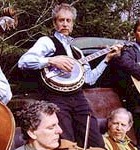
Sir Horace Snetterton
Little is known about the early life of Horace "Stumpy" Snetterton. He was found as an infant in an empty box of export quality vegemite on the steps of the London School of Economics . His foster parents were skilled musicians who regularly toured Europe and America with Snetterton's Banjo Big-Time Spectacular Musical Circus. Horace's life-long interest in the practical applications of electricity to Stupidcomputing can be traced back to when he was struck by lightning at the age of 6 while absent-mindedly playing with his mother's banjo (which unfortunately acted like a lightning-rod). The fused shell of the blacked banjo is preserved and displayed proudly in the entrance foyer of the NCSA Head Office to this day, and it remains an ever-popular waypoint for tourists passing through Melbourne Australia.
The early part of Horace's career
was dogged by failure as he repeatedly tried to apply electricity to computational
devices such as the Electric Sundial,
the Electric Slide-Rule
and the Electric Abacus.
After decades of lonely experimentation in the basement of a small rented
house in Walthamstow
in north London, Horace stumbled across the idea that would eventually
become the Multiphase Step-Down Bi-directional Interocetor,
the device upon which practically every modern computer is based (folklore
says that the idea came to him in a dream). Horace was knighted at the
age of 46, and shortly afterwards moved to Australia and founded the Nancy
Street Centre for Stupidcomputing Applications. In a sad twist-of-fate,
Sir Horace was playing the banjo at the NCSA Christmas party two years
ago [see picture] when he was struck by lightning
again. Paramedics quickly packed Sir Horace in liquid helium
to preserve his vital signs, and he remains to this day frozen and held
in storage in the lowest level of the NCSA Head Office. The NCSA payroll
department has him officially listed as "on indefinite compassionate
leave".
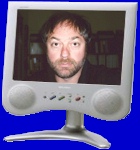
Phillipe Jean de Mentir
"Who's the best and then does better?" The opening lines of a testimonial poem composed by a collaboration of world leaders for a presentation at a joint sitting of the United Nations earlier this year. The testimonial was presented to Phillipe following his keynote address to this historic sitting titled ‘Stupidcomputing and the Future of Humanity.' On that historic day, in a live broadcast to every nation on Earth [see picture], Phillipe explained to an excited and expectant world his plans for the NCSA to help humanity evolve via the application of Stupidcomputing in all areas of science and human endeavour.
Phillipe Jean is clearly the most famous and significant person in the entire history of the human race, his name and fame has covered the globe. "Lucky Phil" or "Swannie" as an admiring world knows him, is the most decorated and distinguished academic in history. Phillipe's sharp insight has reached into and transformed such diverse areas as astronomy, education, mathematics, economics, computer science, philology, philosophy and linguistics. Phillipe is also a master sportsman, musician, composer, poet, diplomat, test pilot and actor. In 1999 Phillipe qualified as the world's first rocket surgeon.
What a fantastic conjunction it
was back in the mid 1970s when Phillipe met Horace Snetterton at a
synchronised
swimming
display in Melbourne Australia, for on that day, a long lasting
friendship was formed between these two great men. With the combined talents
of the dreamy Snetterton and the ever-practical Phillipe, the Nancy Street
Centre for Stupidcomputing Applications was surely destined for greatness,
and nothing could stand in its way.
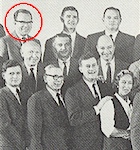
Dr. Winston Holomorph
Dr. Winston was appointed to the board of directors in 1986 after a distinguished career as an NCSA consultant to the world's leading espionage and intelligence agencies. Details about his 15 year career as a consultant in this area are difficult to obtain. It is public knowledge however that he was at various times on the payroll of the FBI, the NSA, GCHQ, Mossad, ASIO, Interpol and the PTA. No one is really sure what Dr. Winston's particular skills are, but they must be significant and appropriate for the NCSA, as shortly after his appointment to the board, a large number of NCSA branches opened-up around the world.
To this day Dr. Holomorph remains a mysterious character who is rarely seen by the public. Visitors to the Nancy Street headquarters say there is a large office with a desk and name plate bearing his name in clear view, but no one has ever seem him there. The only known picture of Dr. Holomorph [circled in the top left of the picture] was smuggled out of the 1965 "Spy Frolics" where he was singing in the massed barbershop choir.
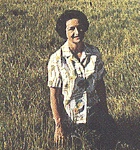
Dr. Elizabeth Naseberry
Sir Horace and Phillipe met Elizabeth Naseberry at a reception in Paris following the awarding of Phillipe's 5th Nobel Prize in 1979. Unsubstantiated rumours have been circulating for years now that Phillipe and Elizabeth had a whirlwind romance, and that explains why they both dropped out of public view for many months around that time. As usual, the truth is far more interesting than the fiction. At that time, Phillipe was working secretly on the development of the Space Shuttle and the Hubble Telescope , and Dr. Naseberry was exercising her skills as a multi-skilled scientist on a lone trek through the swamps and tundra of northern Russia [see picture] to investigate the " Tunguska event ".
Despite the extreme difficulty of Dr. Naseberry's trek into the inhospitable depths of Siberia she completed her work and finally disproved the popular theories that the explosion was caused by a miniature black-hole or the discarded engine of a UFO. Sadly, her reports were classified as Top Secret by the U.S. government of the time and remain unavailable in the public domain. The secrecy continues to fuel the cries of conspiracy theorists.
Strangely enough, Dr. Naseberry's role on the board of the NCSA is mainly a diplomatic one. She travels the world continually to exchange cultural and technical ideas for the mutual benefit of the NCSA and the rest of the world. Most people would be familiar with Dr. Naseberry through her recent international TV science documentary series titled From Sponge to Space.
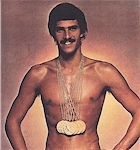
Percival Monochord
Although Percival Monochord's main role is as the 'financial guru' of the NCSA, carefully balancing the vast quantities of money that circulate through the company every day, sports lovers around the globe known him as 'Perky Percy', the ever-optimistic and smiling patron of all forms of sports and leisure activities. It's a mystery how Percival Monochord can so ably fulfil his role as the NCSA's Financial Controller and still have so much time for sports. There is barely a form of sport remaining in the world that Percival has not contributed to in some way, either as a patron, or as a skilled participant. Who can forget his brilliant performance in the last Olympic Games [see picture] where he competed on behalf of 7 countries simultaneously and won a total of 34 medals, including 13 gold, 9 silver and 3 bronze.
It's less well known that Percival has invented many new forms of sport including Cross Country Snooker, Nude Sky Diving, Dwarf Tossing, Sundial Racing, Cloud Spotting, Fractal Chess, Metal Knitting, Banjo Tuning and Underwater Volleyball.
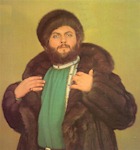
George Zygotene
George joined the NCSA in 1987 as the Manager of Public Relations & Sales after a long and brilliant career as a musician, piano tuner and musical inventor. Sir Horace--who has always been a patron of the arts--met George at a performance of Richard Strauss' opera Elektra where he was conducting the orchestra and singing baritone in the role of Orestes [see picture]. George is most famous for his interpretations of 20th century programmatic music and symphonic poems, and has been on several TV specials over the last few years presenting beginner's guides to modern music.
George has invented many new forms of musical instruments
and composed major orchestral works to demonstrate their unique qualities.
His Concerto for Stringed Trumpet was recently premiered by the
Berlin
Philharmonic
, and the haunting sound of the Acoustrolectric Left-valved
Vamp Horn was used most effectively in the soundtrack of
Stanley
Kubrik's
most recent film.
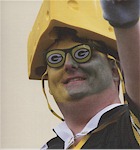
Leonard Bolide
Leonard joined the NCSA in 1988 as the Manager of Software Development. He is famous as the inventor of the 8-speed extensible cup-holder, the laser printer tattooing attachment, the flatbed scanner and tanning salon, and most recently for the public release of Lossy Compression.
Leonard is a keen gourmet and chef in his spare time, and he's almost as famous for his regular appearances on cooking shows as he is for his software. Leonard is a world expert on cheese making and has a sophisticated laboratory in his home where he makes experimental cheeses. His cheeses are more than just a delicious after dinner treat with fruit and crackers, some of his cheeses have practical applications in aircraft frame design and ultra high pressure anvils. Some of Leonard's cheeses are wearable [see picture] and are often seen as accessories on the fashion catwalks of Paris and Milan.